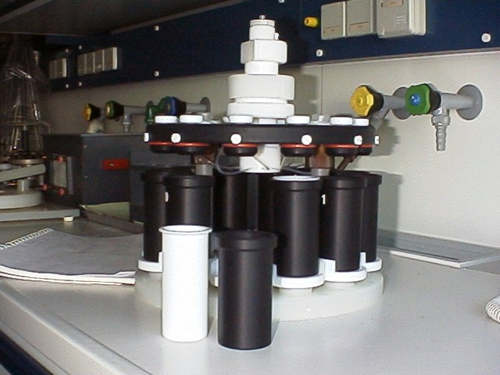| Microwave digestion |  |
||||||||||||||||
| type | MLS Ethos 1600 | ||||||||||||||||
| spec | Microwave digestion system with PTFE digestion cups that fit into both, digestion and evaporation rotors. Vapor condensation and neutralization. Process control by PTFE coated pressure and temperature sensors. | ||||||||||||||||
| solutions |
HNO3, conc.
65% , suprapure Merck # 100441 |
||||||||||||||||
| sample size | approx. 50 mg weighed directly into PTFE sample cups | ||||||||||||||||
| digestion solution |
3mL HNO3, 2mL HF, 2mL HCl |
||||||||||||||||
| pressure digestion |
time [min] |
2
|
1
|
2
|
3
|
4
|
6
|
12
|
30
|
30
|
|||||||
|
Power [Watts] |
250
|
0
|
250
|
550
|
800
|
1000
|
700
|
vent.
|
cool
|
||||||||
| Evaporation rotor |
|
||||||||||||||||
| Evaporation |
time [min] |
50
|
|||||||||||||||
|
Power [Watts] |
350
|
||||||||||||||||
| Homogenization |
add 0.5 mL HNO3 and 4.5 mL pure water |
||||||||||||||||
|
time [min] |
15
|
30
|
|||||||||||||||
|
Power [Watts] |
400
|
vent
|
|||||||||||||||
| dilution |
add 45 mL pure water and transfer solution from digestion cups to 100 mL Greiner sample vials |
||||||||||||||||
| Cup Cleaning |
use 8 mL HNO3, 5% |
||||||||||||||||
|
time [min] |
5
|
5
|
5
|
10
|
|||||||||||||
|
Power [Watts] |
250
|
400
|
550
|
vent.
|
|||||||||||||
|
rinse with pure water |
|||||||||||||||||
|
dry at 60°C in dryer box |
|||||||||||||||||
| tips + tricks |
The advantage
of the MLS Ethos system is, that the samples remain inside the same
PTFE digestion cups during all steps. This reduces contamination
sources |
||||||||||||||||
